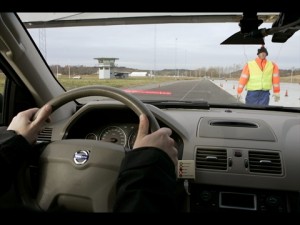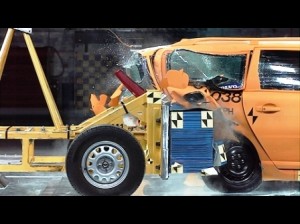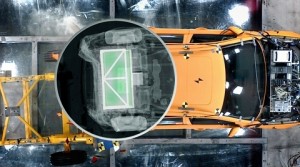Volvo Car Corporation’s short-term target is that no one will be killed or injured in a new Volvo car by 2020 the company said today.
“Zero is the one and only solution for us. As the leader in car safety we can’t accept that people are killed or injured just because they want to transport themselves from A to B,” says Jan Ivarsson, head of Safety Strategy at Volvo Cars. “Our aim is to come so close to zero that one single car accident is defined as a disaster, not an acceptable part of our daily lives.”
If indeed no one is killed or injured in a new Volvo by 2020, it would be a breakthrough in automotive safety. The laws of physics work mightily against such a goal as disparities in vehicle size or high-speed impacts involve energy levels that the human body cannot survive.
Nonetheless, Volvo claims that it has been working towards zero ever since the company was founded in 1927. The aim has always been to make every new car model safer than the previous one.
In recent years, the focus at most auto companies has moved from protection to prevention, a way around the Newtonian F=MA issue. New, albeit expensive, technologies such as collision warning and automatic braking systems or lane wandering detection are now in production.
Volvo says its strategy includes a broader view of safety than the traditional focus on accidents. The safety experts apply a holistic perspective where the safety aspects can be divided into five phases:
- Normal driving – The driver is well informed and can stay alert.
- Conflict – Technology helps the driver to handle the difficult situation.
- Avoidance – The car acts automatically to avoid a collision if the driver fails to react.
- Damage reduction – The car’s safety systems help to reduce the crash energy in order to minimize the effect on the occupants.
- After collision – The car automatically calls for assistance.
The goal and challenge is to keep the driver in the normal driving mode. To reach Volvo’s zero vision, Volvo has to deal with most of the potential issues at this stage, and help the driver back to “normal” if a critical situation occurs.
Here’s where intelligent warning and braking technologies can help.
Late-model Volvos can be equipped with a number of devices that detect potential dangers and help the driver deal with them – either through a warning or, if necessary, by automatic braking.
“When you introduce an automatic system you have to make sure that you don’t create a more dangerous situation than the one you want to prevent. It is not hard to make the car brake automatically. The challenge is to know when it must brake. The detection technology must be reliable,” says Jan Ivarsson.
Volvo has already introduced a number of preventive systems that detect moving and stationary vehicles in front of the car and, next year, Volvo will offer customers a new feature that detects pedestrians.
In the future cars must be able to communicate and exchange information with the infrastructure and other vehicles on the road. In principle, a future Volvo will be able to “speak” to an oncoming vehicle, potentially communicating: “You and I are about to collide head on. If our drivers don’t react, we have to do something. Let’s steer clear of the danger.”
The major challenge to make this scenario possible is to find a common language. (I’ll forgo a Swedish language joke here.) Vehicles of all makes would have to be able to exchange information with the traffic environment.
“We believe that the key is to use systems that are already available for other purposes. The air around us is already charged with communication, most of it used for pleasure or convenience. Adding traffic safety communication to this existing architecture is a far more sensible route than trying to invent and agree on a completely new “language” for communicating in the traffic environment,” says Jan Ivarsson.
Co-operation with other players?
This quest for an accident free future also includes a close co-operation with the Swedish Road Administration to promote the co-operation between vehicles and the infrastructure needed.
“They also have a zero vision, so we have mutual interests. We are co-coordinating our efforts and research projects in order to maximize the results,” says Jan Ivarsson.
Two trends have significant implications of the development of a safer traffic environment:
- The growing number of elderly drivers with an active lifestyle and a higher demand for individual mobility than previous generations.
- The development of more support systems in the cars.
Volvo is building up valuable knowledge in both these areas through major research projects within the company and in co-operation with other players.
Study of older drivers at intersections
Volvo Cars’ Senior Safety Advisor Thomas Broberg is behind a research project at the Swedish National Road and Transport Research Institute (VTI) to study elderly drivers visual search behaviors at intersections.
“There is nothing in the study that indicates that an older person is a more dangerous driver at intersections. However, there is a difference when it comes to handling the situation, for example how to position the car and how the driver moves their head and eyes. These findings are valuable for us when we design our cars and develop new safety systems,” says Broberg.
Camera equipped Volvos in European field test
Volvo is also part of the European project euroFOT (Field Operational Tests). One hundred Volvo V70 and XC70 cars are equipped with technology that monitors the driver’s behavior. The aim is to gain more knowledge about how we react as human beings in complex traffic situations.
The cars are equipped with cameras that record the driver’s head and eye movements, together with a data logger that records the information from the safety features in the car. Other cameras will film the driver’s view of the road. The signals and the videos are saved on a hard disk from where the researchers can analyze the driver’s head and eye movement patterns.
“This helps us to better understand the interaction between driver, car and the traffic environment. The interface between human and machine (HIM) is one of our key research areas. All instruments and functions must be easy to understand and use. It is vital that new information and support technology in our cars is designed and co-coordinated in the right way. The information must help the driver without stealing attention,” says Ivarsson. He adds: “A couple of years ago, we introduced a basic information management feature, IDIS, which blocks incoming phone calls when the driving demands full attention. Our aim is to refine the technology so it can manage information to fit each driving situation.”
In the meantime don’t be caught sitting on the most significant safety device ever invented – your seatbelt.



